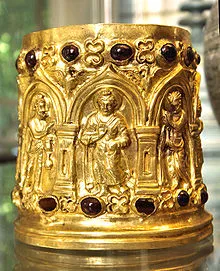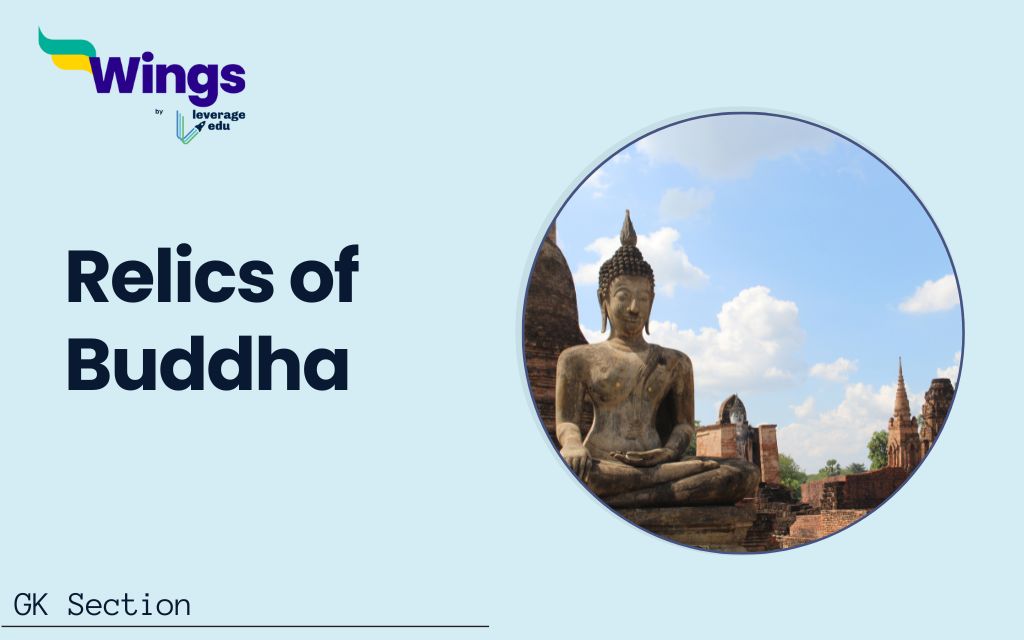Early Buddhist religion and scriptures had a major impact on historical records. The art, architecture, and sculpture of that historical period provide a quick understanding of its rich culture. The relics that remain now are evidence to its heritage. In this section, we will learn about Buddha’s relics, which hold great value to Buddhist culture and tradition. This topic will help students prepare for exams such as UPSC.
Contents
What are the Relics of Buddha?
Buddha’s relics are spiritually significant in the Buddhist religion. These relics are believed to represent Gautama Buddha’s physical items used for pilgrimage and meditation. The preservation and worship of relics is deeply rooted in their belief.

Buddha died in 483 BCE and was cremated in Kushinagar. The Brahmin Drona split the ashes and bone fragments into eight parts and constructed stupas to preserve the relics. This division represents the beginning of paying respects to the Buddha’s remains. This resulted in varying forms of relics in different places.
Also Read: Buddhist Art, Architecture and Literature
Types of Buddha’s Relics
The relics of Buddha are categorized into ten parts, which are enshrined in various sacred sites.
- Bone Relics: These include bone fragments, teeth, and even whole skeletal remains. The most cherished bone relic is Buddha’s collarbone, which is housed in various stupas throughout South Asia.
- Footprint Relics: Carvings of Buddha’s footprints are honoured. These footprints have been found in sites where Buddha has visited.
- Hair Relics: Strands of Buddha’s hair are also considered sacred and are kept in the Shwedagon Pagoda in Myanmar.
- Ashes: Buddha’s cremated remains are also scattered in many stupas. These ashes represent Buddha’s ultimate freedom from the cycle of birth and death.
- Blood Relics: In certain traditions, drops of the Buddha’s blood are regarded as relics, although they are very rare.
- Dharmakaya Relics: These relics are not tangible, but rather symbolic representations of the Buddha’s teachings and enlightenment.
- Stupa Relics: The actual relics are housed in stupas themselves. The stupa’s structure depicts the Buddha’s body, speech, and mind, and it serves as a place to meditate and pray.
- Tooth Relics: These relics are regarded as the most precious relics in Buddhism. The Temple of Tooth, located in Kandy, Sri Lanka, has the most famous tooth relics.
- Buddha’s Robes: Fragments of the Buddha’s garments are considered highly sacred and are kept in monasteries and temples.
- The Buddha’s alms bowls: They represent his teachings on simplicity and detachment, which are also part of his relics.
Also Read:Jainism Philosophy UPSC: Philosophy and Literature
Major Sites of Buddha’s Relics
Buddha’s relics are spread over several regions, which are considered sacred sites in Buddhism.
- Sanchi Stupa, India: Sanchi Stupa is one of India’s oldest stone structures. These stupas are thought to store the relics of Buddha’s followers, however, other people associate them with Buddha’s relics.
- Kushinagar, India: This is the location of the Buddha’s parinirvana, where some relics were originally kept.
- Temple of the Tooth, Sri Lanka: The Temple of the Tooth is located in Kandy, Sri Lanka. This temple holds the Buddha’s precious tooth relic. It’s a UNESCO World Heritage site and a popular pilgrimage destination.
- Shwedagon Pagoda, Myanmar: This pagoda is one of the world’s most well-known and renowned stupas. It is believed to include strands of the Buddha’s hair.
- Wat Phra That Doi Suthep, Thailand: This stupa is located in Chiang Mai, Thailand. It is thought to be the home of Buddha’s shoulder bone.
- Famen Temple, China: This temple is known for its underground palace, which was discovered in 1987. That palace enshrined Buddha’s finger bone relic.
Also Read: Yakshagana: History, Variants and Salient Features
Rituals of Buddha’s Relics
The Buddha’s Relics are honoured through a variety of rituals and ceremonies. These rituals demonstrate Buddhist people’s devotion to their religion and its teachings. Some of these practices include:
- Pilgrimage: Visiting relic places is a common Buddhist practice. Pilgrims travel long distances to meditate and pray at the sacred sites.
- Circumambulation: Walking around a stupa or relic site is a common practice to show respect for these locations. This act is thought to lead the devotee closer to enlightenment.
- Offerings: Devotees frequently present flowers, incense, and lights as offerings to these sites.
- Relic Processions: In some civilisations, relics are carried through the streets during major festivals, drawing thousands of devotees.
Modern Discoveries and Controversies
Archaeologists have led to numerous new discoveries, causing debates and controversies on the subject.
- Archaeologist excavations have recently revealed fresh relics and stupas.
- New discoveries sparked a renewed interest in Buddhist history and tradition.
- The authenticity of these relics sparked numerous questions and debates.
- Disputes can occur over the right location for enshrinement and devotion.
- The presentation of various relics in museums has raised ethical and religious concerns.
Spiritual Significance of Relics
Buddha’s relics are more than just artefacts; they hold spiritual and religious significance. They are living icons of Buddha’s faith, teachings, and devotion. The relics range from ancient stupas to great temples, and they continue to inspire millions of Buddhists throughout the world.
Their adoration focuses on the Buddha’s lasting legacy and the significant impact of his life and teachings on humanity..Each Buddha relic has significant religious value on its own.
- They serve as a means to connect with Buddha and his teachings.
- Relics inspire faith in their religion’s teachings and serve as a reminder to Buddhists on the path to Nirvana.
- These relics also represent the unity and continuity of the Buddhist community over generations.
Related Posts
| Types of Vedas | Sarnath Lion Capital & Great Stupa of Sanchi |
| Gautam Buddha: Teachings | Buddhism Philosophy and Concepts |
| Four Noble Truths of Buddhism | Jain Councils |
FAQs
Buddha’s relics are spiritually significant things in the Buddhist religion. These relics are believed to represent Gautama Buddha’s physical realms or items used for pilgrimage and meditation. The preservation and worship of relics is deeply rooted in their belief.
There are 10 sects of Buddha Relics which include Bone Relics, Tooth Relics, Hair Relics and Ashes, Blood Relics, Robe Relics, Bowl Relics, Footprint Relics, Dharmakaya Relics and Stupa Relics.
According to UNESCO, the Ramagrama stupa is the only unaffected original stupa carrying Lord Buddha’s relics, having been built in the sixth century BCE.
This was all about the “Relics of Buddha”. For more such informative blogs, check out our UPSCExams Section and Study Material Section, or you can learn more about us by visiting our Indian exams page.
 One app for all your study abroad needs
One app for all your study abroad needs














